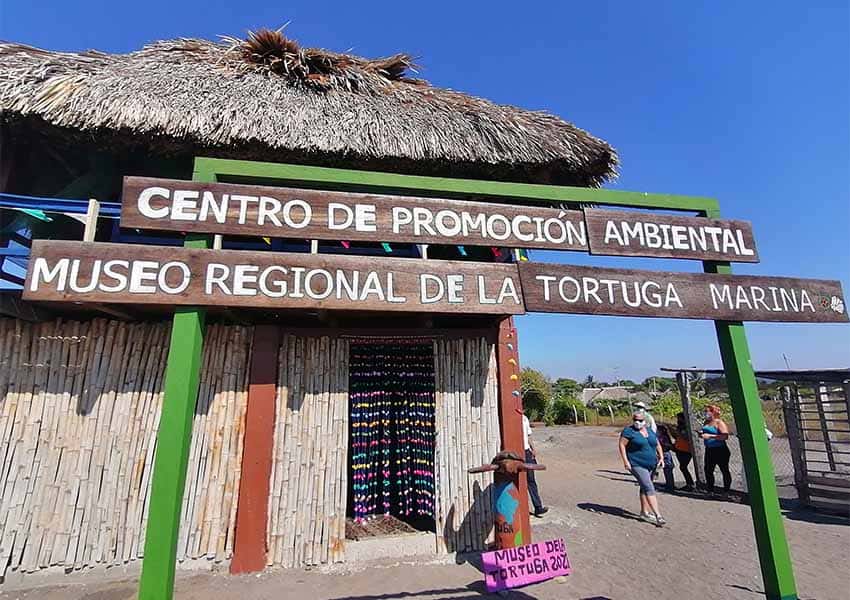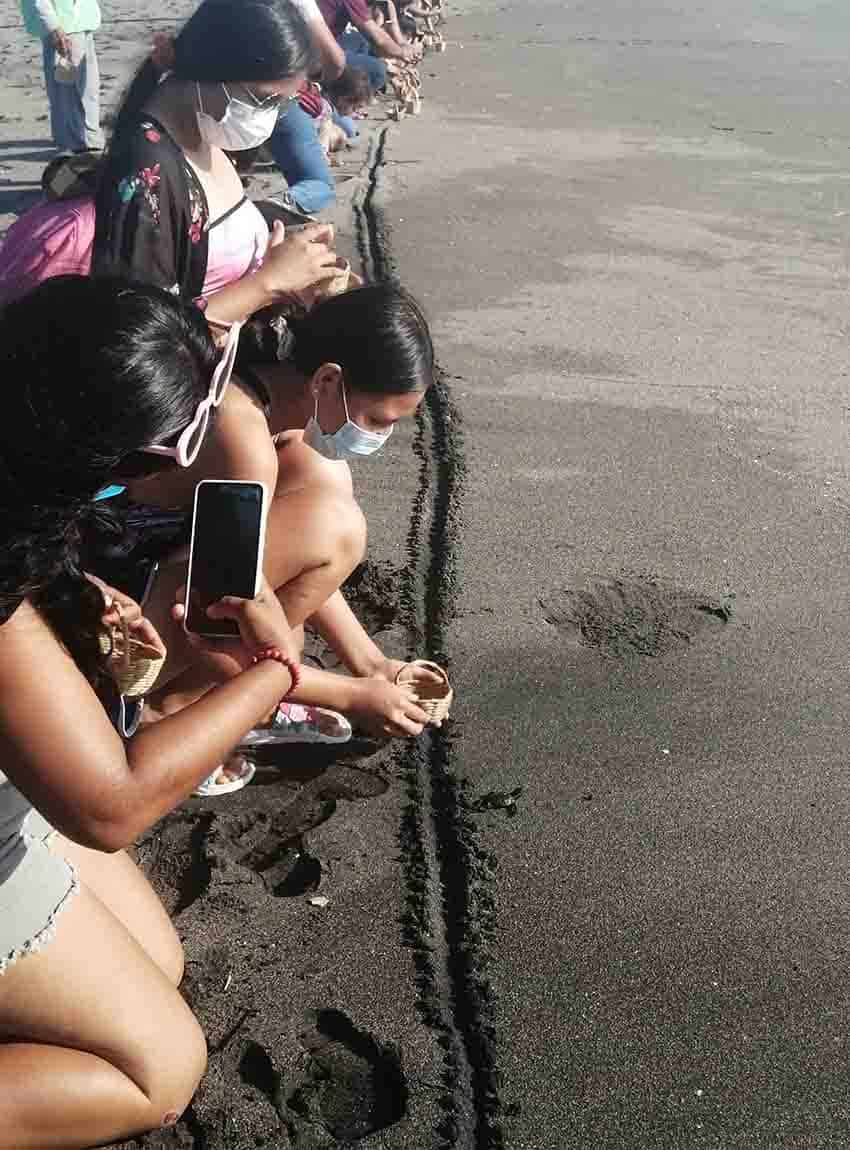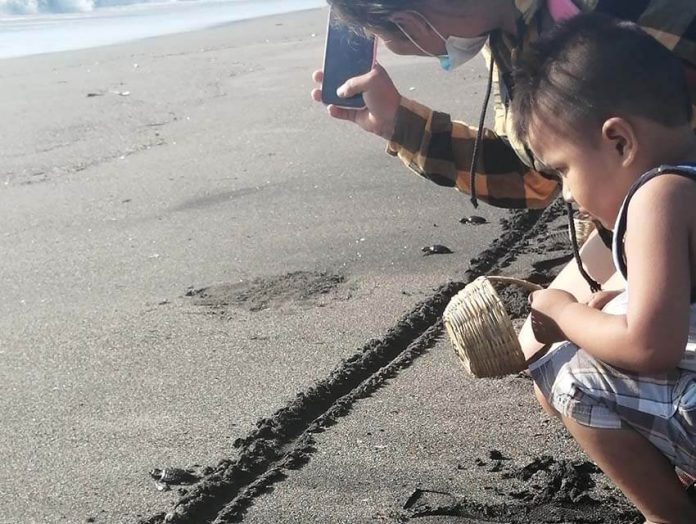Dozens of tiny, black sea turtles waddle towards the ocean waves. Their oversized flippers struggle across the sand, and some of these tiny creatures seem to give up before they start, the immensity of the few meters’ walk too much for their newly hatched bodies. Tourists watch, cheering them on, hoping for good luck on this, the first day of their lives, but their fight to survive has just begun.
Of every thousand of these turtles, rescued from beachside nests and kept safely within the nesting grounds until they hatch, only about 100 will survive until adulthood, so great are turtles’ adversaries – predators, ocean trash that chokes and entangles them and finally the poachers that come along in the moonlight to snatch their eggs and often the turtles’ shells, leaving their shorn bodies behind to bake in the dawn’s rays.
The Chiapas municipality of Emiliano Zapata, a community of only about 300 people made up of three or four families, used to be part of the problem. They joined other poachers in taking the turtles’ eggs and shells to sell on the market or cook as local delicacies.
But three years ago, a small cooperative of concerned community members decided it was their responsibility to protect these majestic creatures or watch them disappear forever.
“Our parents would talk about how there used to be sacks and sacks of eggs,” says Gerónimo Arias de la Cruz, a member of the community and our guide on this hot December day. “Later, as we got older, we found it was rarer and rarer to find them.”

They knew if they didn’t do something that their children would grow up and never get a chance to see these natural wonders. The cooperative applied for a permit from the National Commission for Natural Protected Areas (Conanp), asking if they might collect the eggs from the nests on the beach and protect them from poachers and animal predators in a fenced-in hatching ground a few hundred meters inland.
With the support of Conanp, they began to rescue the turtle eggs. This year, four years into their project, 46 nests — an average of 80 eggs in each — reached the hatching stage under their care.
Emiliano Zapata is part of the Encrucijada Bioreserve, a 35,000-acre expansive of territory that spreads across seven coastal communities in the south of Chiapas. Each has specific species that are endemic to this place, and nowhere else in the world.
Communities are now working with the local government to protect these species and the environments where they make their home, mainly the mangrove forests that line the coast.
The job doesn’t only include the five months of collecting turtle eggs and releasing them into the wild. They also work to prevent fires in the mangrove forest, to clean up the beach and to reforest areas that have been damaged or burnt.
Skulls of poached crocodiles line the walls of the Marine Turtle Environmental Educational Center, along with the bones of animals burnt in fires and the dried-out bodies of turtles left to suffocate on the beach without their shells. It’s a chilling scene, but one that the community hopes will build conscientiousness in the visitors about the important conservation work going on here.

They also want to bring ecotourism to their area — a region of Mexico that is one of the country’s poorest. Each member of the community receives only about US $150 for the entire five months he or she works with the turtles – going on patrols, retrieving eggs and guarding their hatching grounds from poachers.
“When they see someone that is paying attention, they tend not to come around,” says José Alfredo González, a local biologist who works with the coop giving tours. A tone of frustration can be heard in his voice when he describes the speed at which poachers can collect eggs on the beach with motorcycles and horses.
The community members are not vigilantes; they are just there to inform the local authorities and often invite them out on patrol so they can see what’s happening for themselves. They are currently raising money for a four-wheeler of their own in order to compete with the slick and fast-moving poachers that still haunt the shores.
While the community has no hard and fast numbers about how much of the sea turtle population has disappeared over the years, Arias says the difference between when he was a child and now is shocking.
“It was part of my childhood. Before, you could just walk out onto the beach and see them [laying their eggs]. Now that I am an adult, it’s not so easy. To find a nest, we have to walk five or six kilometers down the beach.”
Children run here and there throughout the beautifully painted rooms of the Marine Turtle Education Center. Walls are adorned with images of the five types of mangrove, the seven kinds of sea turtles worldwide and the elegant migratory birds that come every year to raise their own offspring in the bioreserve.

The town’s children are absorbing from their elders that this a problem that must be addressed, and as they carry tiny turtles out to the sea in hollowed-out gourds, they aren’t just helping their own little swimmers; they are assisting the survival of an entire species, one turtle at a time.
• To arrange a visit contact Travis Tours in Chiapas which works directly with community members to support their project via ecotourism.
Lydia Carey is a regular contributor to Mexico News Daily.
